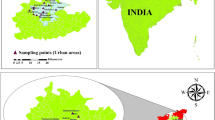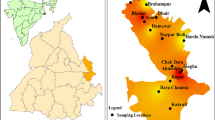Abstract
The present study deals with the assessment of the fluoride concentration from 60 different spatially distributed well locations and associated health risks to rural residents in the Achhnera block of Agra, Western Uttar Pradesh, India. Monte Carlo simulation and sensitivity analysis were applied to quantify uncertainties in risk estimation. Assessment of the human health risk was carried out using computations based on fluoride ingestion (EDIing), dermal absorption of fluoride (EDIder) and hazard quotient (HQ) in all three categorized groups, i.e., infants, children, and adults. Fluoride concentration analyzed was found to be ranging between 0.15 and 2.50 mg/L with an average value of 1.51 mg/L. More than 58% of samples analyzed surpassed the permissible level as per drinking water specifications. From the model obtained for non-carcinogenic risk due to water ingestion, values of IRw range between 55.4% and 62.5% in all the three exposure groups, while that of Cw ranges between 37% and 42.8%. Based on the HQ investigation it was found that infants were at maximum risk followed by children and the least affected were adults. Results showed that based on the sensitivity analysis, a definition of the probability distributions of CW, IRw, EF and SA is presented as the main factor to improve the accuracy of the result.




Similar content being viewed by others
References
Adimalla N, Li P, Qian H (2019) Evaluation of groundwater contamination for fluoride and nitrate in semi-arid region of Nirmal Province, South India: a special emphasis on human health risk assessment (HHRA). Hum Ecol Risk Assessm Int J 25(5):1107–1124
Aldrees AM, Al-Manea SM (2010) Fluoride content of bottled drinking waters available in Riyadh, Saudi Arabia. Saudi Dent J 22(4):189–193
Ali S, Kumari M, Gupta SK, Sinha A, Mishra BK (2017) Investigation and mapping of fluoride-endemic areas and associated health risk—A case study of Agra, Uttar Pradesh, India. Hum Ecol Risk Assessm Int J 23(3):590–604
Amouei A, Mahvi A, Mohammadi A, Asgharnia H, Fallah S, Khafajeh A (2012) Fluoride concentration in potable groundwater in rural areas of Khaf city, Razavi Khorasan province, Northeastern Iran. Int J Occup Environ Med (The IJOEM) 3:1
APHA (2012) Standard methods for the examination of water and wastewaters, 22nd ed. APHA, assessment, EPA/600/Z-92/001, risk assessment forum. Washington, DC. AWWA, WEF, Washington, DC
Ayoob S, Gupta AK, Bhat VT (2008) A conceptual overview on sustainable technologies for the defluoridation of drinking water. Crit Rev Environ Sci Technol 38(6):401–470
Bazeli J, Ghalehaskar S, Morovati M, Soleimani H, Masoumi S, Rahmani Sani A, Saghi MH, Rastegar A (2020) Health risk assessment techniques to evaluate non-carcinogenic human health risk due to fluoride, nitrite and nitrate using Monte Carlo simulation and sensitivity analysis in Groundwater of Khaf County, Iran. Int J Environ Anal Chem 1:1–21
Biglari H, Chavoshani A, Javan N, Hossein Mahvi A (2016) Geochemical study of groundwater conditions with special emphasis on fluoride concentration, Iran. Desalin Water Treatment 57(47):22392–22399
Daw RK (2004) Experiences with domestic defluoridation in India. In Proceedings of the 30th WEDC International Conference on People-Centred Approaches to Water and Environmental Sanitation, Vientiane, Lao PDR, vol 25, pp 467–473
Dehghani MH, Zarei A, Yousefi M, Asghari FB, Haghighat GA (2019) Fluoride contamination in groundwater resources in the southern Iran and its related human health risks. Desalin Water Treatment 153:95–104
Fallahzadeh RA, Miri M, Taghavi M, Gholizadeh A, Anbarani R, Hosseini-Bandegharaei A, Ferrante M, Conti GO (2018) Spatial variation and probabilistic risk assessment of exposure to fluoride in drinking water. Food Chem Toxicol 113:314–321
Faraji H, Mohammadi AA, Akbari-Adergani B, Saatloo NV, Lashkarboloki G, Mahvi AH (2014) Correlation between fluoride in drinking Water and its levels in breast milk in Golestan Province, Northern Iran. Iran J Public Health 43:166
Fawell J, Bailey K, Chilton J, Dahi E, Magara Y (2006) Fluoride in drinking-water. IWA Publishing, London
Fernández-Macias JC, Ochoa-Martínez ÁC, Orta-García ST, Varela-Silva JA, Pérez-Maldonado IN (2020) Probabilistic human health risk assessment associated with fluoride and arsenic co-occurrence in drinking water from the metropolitan area of San Luis Potosí, Mexico. Environ Monit Assessm 192(11):1–13
Ghaderpoori M, Khaniki GRJ, Dehghani M, Shams M, Zarei A (2009) Determination of fluoride in bottled water sold in Tehran market, Iran. Am Eurasian J Agri Environ Sci 6(3):324–327
Gopalakrishnan S, Mebrahtom K (2006) Prevalence of fluorosis in certain villages of Ghindae area of Eritrea, North East Africa-suggestions for prevention and control. Indian J Environ Prot 26(3):202
India P (2011) Census of India 2011 Provisional Population Totals. Office of the Registrar General and Census Commissioner, New Delhi
Integrated Risk Information System (IRIS) (2007) US Environmental Protection Agency
Jones S, Burt BA, Petersen PE, Lennon MA (2005) The effective use of fluorides in public health. Bull World Health Organ 83:670–676
Khan SU, Noor A, Farooqi IH (2015) GIS application for groundwater management and quality mapping in rural areas of District Agra, India. Int J Water Resource Arid Environ 4(1):89–96
Khan SU, Farooqi IH, Usman M, Basheer F (2020a) Energy efficient rapid removal of arsenic in an electrocoagulation reactor with hybrid Fe/Al electrodes: process optimization using CCD and kinetic modeling. Water 12(10):2876
Khan SU, Asif M, Alam F, Khan NA, Farooqi IH (2020b) Optimizing fluoride removal and energy consumption in a batch reactor using electrocoagulation: a smart treatment technology. Smart Cities—Opportun Challeng. Springer, Singapore, pp 767–778
Kotecha PV, Patel SV, Bhalani KD, Shah D, Shah VS, Mehta KG (2012) Prevalence of dental fluorosis & dental caries in association with high levels of drinking water fluoride content in a district of Gujarat, India. Indian J Med Res 135(6):873
Mateen QS, Khan SU, Islam DT, Khan NA, Farooqi IH (2020) Copper (II) removal in a column reactor using electrocoagulation: parametric optimization by response surface methodology using central composite design. Water Environ Res 92:1350–1362
Means B (1989) Risk-assessment guidance for superfund. Volume 1. Human health evaluation manual: Part A. Interim report (Final) (No. PB-90-155581/XAB; EPA–540/1-89/002). Environmental Protection Agency, Washington, DC (USA). Office of Solid Waste and Emergency Response
Mirzabeygi M, Yousefi N, Abbasnia A, Youzi H, Alikhani M, Mahvi AH (2017) Evaluation of groundwater quality and assessment of scaling potential and corrosiveness of water supply networks, Iran. J Water Supply Res Technol AQUA 66(6):416–425
Mohammadi AA, Zarei A, Majidi S, Ghaderpoury A, Hashempour Y, Saghi MH, Alinejad A, Yousefi M, Hosseingholizadeh N, Ghaderpoori M (2019) Carcinogenic and non-carcinogenic health risk assessment of heavy metals in drinking water of Khorramabad, Iran. MethodsX 6:1642–1651
Mumtaz N, Pandey G, Labhasetwar PK (2015) Global fluoride occurrence, available technologies for fluoride removal and electrolytic defluoridation: a review. Crit Rev Environ Sci Technol 1:1. https://doi.org/10.1080/10643389.2015.1046768
National Research Council (NRC). (2001). National Academics Press. Washington, DC
Qasemi M, Shams M, Sajjadi SA, Farhang M, Erfanpoor S, Yousefi M, Zarei A, Afsharnia M (2019) Cadmium in groundwater consumed in the rural areas of Gonabad and Bajestan, Iran: occurrence and health risk assessment. Biol Trace Elem Res 192:106–111
Radfard M, Yunesian M, Nabizadeh R, Biglari H, Nazmara S, Hadi M, Yousefi N, Yousefi M, Abbasnia A, Mahvi AH (2019) Drinking water quality and arsenic health risk assessment in Sistan and Baluchestan, Southeastern Province, Iran. Hum Ecol Risk Assessm Int J 25(4):949–965
Rezaei H, Zarei A, Kamarehie B, Jafari A, Fakhri Y, Bidarpoor F, Karami MA, Farhang M, Ghaderpoori M, Sadeghi H, Shalyari N (2019) Levels, distributions and health risk assessment of lead, cadmium and arsenic found in drinking groundwater of Dehgolan’s villages, Iran. Toxicol Environ Health Sci 11(1):54–62
Smith RL (1994) Use of Monte Carlo simulation for human exposure assessment at a superfund site. Risk Anal 14(4):433–439
USEPA (U.S. Environmental Protection Agency) (1989). Risk Assessment Guidance for Superfund Volume I: Human Health Evaluation Manual (Part E, Supplemental Guidance for Dermal Risk Assessment). Final. EPA/540/R/99/005. U.S. Environmental Protection Agency, Office
WHO G (2011) Guidelines for drinking-water quality. World Health Organization 216:303–304
WHO (World Health Organization) (2002) Environmental Health Criteria, vol 227. Fluorides, Geneva, pp 1–251
Williams PR, Scott PK, Sheehan PJ, Paustenbach DJ (2000) A probabilistic assessment of household exposures to MTBE from drinking water. Hum Ecol Risk Assessm 6(5):827–849
Yadav KK, Gupta N, Kumar V, Choudhary P, Khan SA (2018) GIS-based evaluation of groundwater geochemistry and statistical determination of the fate of contaminants in shallow aquifers from different functional areas of Agra city, India: levels and spatial distributions. RSC Adv 8(29):15876–15889
Yousefi M, Ghoochani M, Mahvi AH (2018) Health risk assessment to fluoride in drinking water of rural residents living in the Poldasht city, Northwest of Iran. Ecotoxicol Environ Saf 148:426–430
Yousefi M, Moghaddam VK, Nasab SM, Nabizadeh R, Hadei M, Zarei A, Asghari FB, Mohammadi AA (2019) Northwest of Iran as an endemic area in terms of fluoride contamination: a case study on the correlation of fluoride concentration with physicochemical characteristics of groundwater sources in Showt. Desalin Water Treatment 155:183–189
Acknowledgements
The principal author (Mr. Shahjad Ali) would like to thank the Director of Anand Engineering College, Agra, and Department of Environment Science and Engineering, IIT (ISM Dhanbad), India, for providing all the facilities for this study.
Author information
Authors and Affiliations
Corresponding author
Ethics declarations
Conflict of interest
The authors declare that they have no known competing financial interests or personal relationships that could have appeared to influence the work reported in this paper.
Additional information
Editorial responsibility: Josef Trögl.
Rights and permissions
About this article
Cite this article
Ali, S., Khan, S.U., Gupta, S.K. et al. Health risk assessment due to fluoride exposure from groundwater in rural areas of Agra, India: Monte Carlo simulation. Int. J. Environ. Sci. Technol. 18, 3665–3676 (2021). https://doi.org/10.1007/s13762-020-03084-2
Received:
Revised:
Accepted:
Published:
Issue Date:
DOI: https://doi.org/10.1007/s13762-020-03084-2




